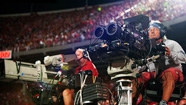Production companies will continue to produce 2-D and 3-D separately

Although the sports production community would like to find a way to cost-effectively produce a 3-D production with a single truck that can also produce the 2-D version, it probably won't be practical for several years.
That's because there's still a large learning curve for producers and crews to figure out how best to capture a live sporting event in 3-D and other logistics that are more clearly understood for high-definition 2-D projects.
"For the moment, it looks like we're going to be looking at two separate productions for a while," said Ken Aagaard, executive vice president of engineering, operations and production for CBS Sports. "For the production of 3-D, cameras really have to be in different positions than with 2-D HD. That's a struggle for us because of the different venues we work in and the availability of camera locations available to us. We can't have fans jumping up and down in front of a 3-D rig. It will drive viewers crazy."
He said that there are situations where a 2-D HD camera can be used to supplement a 3-D broadcast, but the amount of signal processing and other production values unique to 3D production make it risky to mix with the traditional HD broadcast on a large scale. CBS Sports tried this during its coverage of the NCAA Men's Final Four college basketball championship weekend. An overhead HD aerial "ActionCam" camera was mixed in with the lower 3-D shots for the game coverage. The signal from the camera was passed through the production switcher twice to create a pseudo 3-D effect that was not immediately obvious to the viewer.
"So, there are opportunities to mix 2-D cameras in with 3-D productions because we're all trying to figure out how to get the cost of producing a live event down as much as possible," Aagaard said. "It's a similar situation to what we went through while transitioning from SD to HD production. However, I think the transition from HD to 3-D is going to take a bit longer."
Steve Hellmuth, executive vice president, operations and technology for the NBA, says "there's a great deal of attention to detail during a 3-D telecast that starts with the camera positions, then extends to the director, the camera operators, the convergence operator and the rest of the crew."
Trying to accomplish this while also thinking about a 2-D production is a lot to consider.
The professional video industry's #1 source for news, trends and product and tech information. Sign up below.
"HD didn't change the way we approached a live sports production that much, but 3-D really is different," Hellmuth said. "We need to let the viewer live inside the frame, which takes a lot of thought and careful planning. That means slowing down the shots and instructing the crew to pay attention a whole series of details they don't have to with HDTV."
Chuck Pagano, executive vice president, technology, engineering and operations, ESPN, calls the current state of 3-D production "the ultimate science project." The network has done a number of controlled tests earlier this year with the Harlem Globetrotters at ESPN's "Wide World Of Sports" R&D facility at Walt Disney World in Orlando, FL, and learned few lessons that will come in handy next month during the World Cup tournament. ESPN 3-D will sign on the air June 11 with the first 2010 FIFA World Cup match featuring South Africa vs. Mexico. It will televise up to 25 matches throughout the international soccer tournament.
"We're scrambling the proverbial 3-D egg and still trying to figure out how to do things efficiently and cost-effectively," he said. "We'll get there, but it will take time and real-world experience."
NEP Supershooters has a new 3-D truck that will be used by ESPN for its coverage of the MLB All-Star Game festivities (including the Home Run Derby) in July. It is building a second truck that will hit the road in July and cover a baseball game in Seattle among other 3-D events to be determined. The company is also considering a third truck, although no firm plans have been initiated.
"The language of 2-D television has evolved over the course of 50 years, based on the fact that your average viewer was watching on a 20in screen," said George Hoover, chief technology office for NEP. "We did extreme close-ups, in much lower resolution, and wide shots to establish what the venue felt like. Interestingly, a lot of those shots don't have a lot of depth information. So I think we have to teach the viewer the new language of watching sports in 3-D because they are going to see things in ways they never could before."
While the finances to produce 3-D are uncertain at best, the real challenge is producing a compelling 3-D experience while still covering the game. The "wow" factor goes away when you can't tell what's going on during the game.
